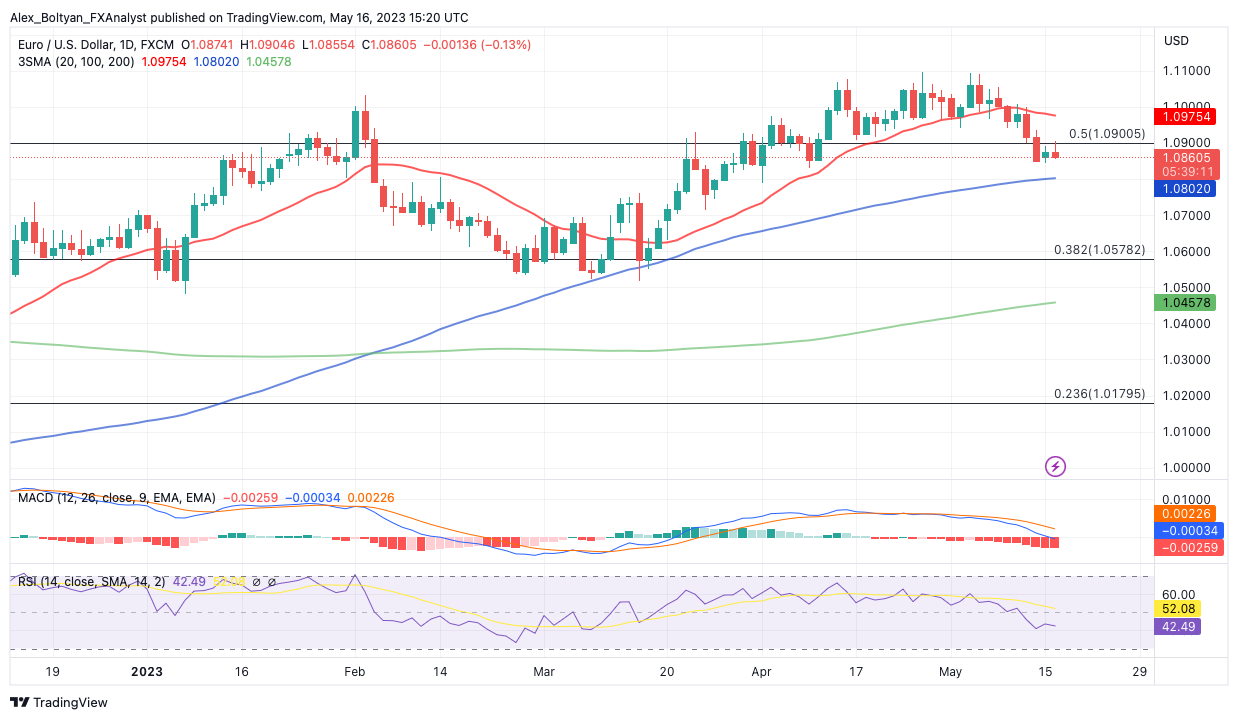The EUR/USD pair staged a short-lived bounce on Tuesday, but it was rejected from the 1.0900 area despite encouraging Eurozone Gross Domestic Product (GDP) figures.
At the time of writing, the EUR/USD pair is trading at the 1.0865 zone, a few pips below its opening price, after hitting an intraday high of 1.0904.
The Eurozone released the preliminary first-quarter GDP numbers, which showed the bloc's economy grew at an annualized pace of 1.3%, in line with expectations. Additionally, the employment change was +1.7% in the same period.
On the other side of the Atlantic, US retail sales came in below expectations, with the headline figure growing 0.4% in April versus the 0.7% increase expected.
Following the release of retail sales, US Treasury yields made a U-turn and now trade with marked gains across the curve, boosting the dollar and weighing on the EUR/USD pair. 
From a technical perspective, the EUR/USD short-term bias has turned slightly bearish according to indicators on the daily chart, which have crossed their midlines and stand in negative territory. Furthermore, the price has fallen below the 20-day simple moving average (SMA) and remains unable to reclaim the 1.0900 level, skewing the risk to the downside.
A break above 1.0900 could pave the way toward the 1.1000 zone en route to 2023 highs at the 1.1095 zone. On the flip side, the loss of the 100-day SMA at 1.0800 would deteriorate the short-term scenario, exposing the 1.0750 area.
From a broader perspective, the EUR/USD pair maintains a positive view while above the 200-day SMA, currently at 1.0460.
- English (UK)
- English (India)
- English (Canada)
- English (Australia)
- English (South Africa)
- English (Philippines)
- English (Nigeria)
- Deutsch
- Español (España)
- Español (México)
- Français
- Italiano
- Nederlands
- Português (Portugal)
- Polski
- Português (Brasil)
- Русский
- Türkçe
- العربية
- Ελληνικά
- Svenska
- Suomi
- עברית
- 日本語
- 한국어
- 简体中文
- 繁體中文
- Bahasa Indonesia
- Bahasa Melayu
- ไทย
- Tiếng Việt
- हिंदी
EUR/USD Recovery Falters at 1.0900, Maintains Short-Term Negative Bias
Published 05/16/2023, 11:24 AM
Updated 07/09/2023, 06:32 AM
EUR/USD Recovery Falters at 1.0900, Maintains Short-Term Negative Bias
Latest comments
Loading next article…
Install Our App
Risk Disclosure: Trading in financial instruments and/or cryptocurrencies involves high risks including the risk of losing some, or all, of your investment amount, and may not be suitable for all investors. Prices of cryptocurrencies are extremely volatile and may be affected by external factors such as financial, regulatory or political events. Trading on margin increases the financial risks.
Before deciding to trade in financial instrument or cryptocurrencies you should be fully informed of the risks and costs associated with trading the financial markets, carefully consider your investment objectives, level of experience, and risk appetite, and seek professional advice where needed.
Fusion Media would like to remind you that the data contained in this website is not necessarily real-time nor accurate. The data and prices on the website are not necessarily provided by any market or exchange, but may be provided by market makers, and so prices may not be accurate and may differ from the actual price at any given market, meaning prices are indicative and not appropriate for trading purposes. Fusion Media and any provider of the data contained in this website will not accept liability for any loss or damage as a result of your trading, or your reliance on the information contained within this website.
It is prohibited to use, store, reproduce, display, modify, transmit or distribute the data contained in this website without the explicit prior written permission of Fusion Media and/or the data provider. All intellectual property rights are reserved by the providers and/or the exchange providing the data contained in this website.
Fusion Media may be compensated by the advertisers that appear on the website, based on your interaction with the advertisements or advertisers.
Before deciding to trade in financial instrument or cryptocurrencies you should be fully informed of the risks and costs associated with trading the financial markets, carefully consider your investment objectives, level of experience, and risk appetite, and seek professional advice where needed.
Fusion Media would like to remind you that the data contained in this website is not necessarily real-time nor accurate. The data and prices on the website are not necessarily provided by any market or exchange, but may be provided by market makers, and so prices may not be accurate and may differ from the actual price at any given market, meaning prices are indicative and not appropriate for trading purposes. Fusion Media and any provider of the data contained in this website will not accept liability for any loss or damage as a result of your trading, or your reliance on the information contained within this website.
It is prohibited to use, store, reproduce, display, modify, transmit or distribute the data contained in this website without the explicit prior written permission of Fusion Media and/or the data provider. All intellectual property rights are reserved by the providers and/or the exchange providing the data contained in this website.
Fusion Media may be compensated by the advertisers that appear on the website, based on your interaction with the advertisements or advertisers.
© 2007-2025 - Fusion Media Limited. All Rights Reserved.
